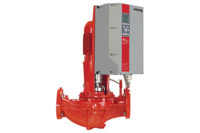Indianapolis-based North Mechanical Contracting & Service has been designing, building and maintaining diverse mechanical, engineering and plumbing systems for more than 40 years.
The company has worked on the MEP systems at several prominent Indianapolis landmarks, including the Indianapolis International Airport, Indianapolis Museum of Art, Anthem, Franciscan Health, Roche Diagnostics, Indiana University, Nestle’s and Purdue University.
Recently, North Mechanical was awarded the company’s largest fabrication contract to-date by one of the area’s largest manufacturers. The firm has successfully used the integrated project delivery (IPD) method to deliver challenging industrial projects on time, under budget and with fewer risks. IPD is a collaborative approach to project delivery that integrates people, systems, business structures and practices of all stakeholders to optimize project results and increase value to the owner.
Dustin Allen, project/BIM manager for North Mechanical, explains technology is fundamental to the IPD process and it is critical for optimizing the design-to-fabrication-to-construction workflow.
“Today, we take on a lot of industrial integrated project delivery builds, which means we have a much bigger role in the actual project design piece,” Allen says. “There is a real need for more intelligent, fabrication-ready models that have the actual system components included. That’s why we turned to Trimble SysQue.”
SysQue is an add-on software for Autodesk Revit that allows contractors to fully design constructible models with real-world intelligent MEP components. With SysQue, North Mechanical’s engineers and designers created precise and accurate project plans in line with detailing, fabrication, manufacturing and installation requirements. As a result, accuracy of designs improved, labor and material costs were reduced and project timelines shortened.
Optimizing the fabrication workflow
For the build on the south side of Indianapolis, North Mechanical was hired to generate material takeoffs and to fabricate all mechanical and plumbing components for the laboratory building. Traditionally, manual processes were used for this type of work, including manual measuring of end-to-pipe, pipe-to-hanger dimensions, manual quantity takeoff and individual component labeling. With the typical fabrication cut sheets consisting of about 50 pieces, elevations and more than 30 fittings each, the process is tedious, prone to errors and inefficient. Looking to eliminate unknowns and create a more automated and accurate fabrication workflow, North Mechanical adopted Trimble SysQue and the Autodesk Revit platform — first for the fabrication of hangers, and then for pipes and components.
“We knew we wanted to eliminate manual steps for fabricators and improve the accuracy and efficiency of everything from fabrication down to installation,” Allen says. “When you add fittings into SysQue, the model is smart enough to give you the pipe length and when you get to the end, pipe length is reflected in the schedule. You can cut 100 pieces at 5 ft., and put pieces on with fittings with extreme accuracy. We knew this would save a tremendous amount of time and rework, and the big payoff would be big savings for our customer.”
North Mechanical uses SysQue to design fully constructible Revit LOD 400 models based on manufacturing-specific content. Using SysQue in Revit enhances the model of systems with materials and sizes based on actual manufacturer products by name and part number. This means fabricators can produce pipes, fittings and hangers more quickly and accurately than using conventional methods. Allen explains that with SysQue, the model of systems includes materials and sizes based on actual manufacturer products by name and part number. This includes relevant fields for spool drawings for fabrication and installation, such as piece number, diameter, nominal size, size, family and type, system classification, system abbreviation, material, count and length.
Using SysQue in Revit also helped North Mechanical coordinate much more effectively with other trades during fabrication and design. For the pharmaceutical manufacturing build, North Mechanical worked closely with Indianapolis-based sheet-metal designer and fabricator Bright Sheet Metal. Rance Pearson, BIM director for Bright Sheet Metal, explains how both used SysQue in Revit and a single model to collaborate, identify potential clashes and make necessary changes on the fly.
“When working with our mechanical piping and plumbing contractor we’d get into a meeting and I could make my adjustments, refresh my model and his piping would show up almost immediately,” Pearson says. “We could share points for our hangers or if we had our total station out there we could shoot them because it’s the same system and all based on the same coordinates. Essentially we could solve a problem very quickly.”
This lab project also helped establish a completely new fabrication workflow for producing piping spools and fabricated skids that can be replicated for other projects, including importing raw-component data into Microsoft Excel and Word to easily organize, print and apply labels to each hanger and component.
“Having this level of manufacturing detail on our hanger and component labels increased our efficiency and allowed us to cut our workforce in half during the peak of the job,” Allen notes. “By allowing us to fabricate roughly 90% of components off-site, we also reduced our footprint on the job and allowed for increased efficiency among our partners because they had more insight into it and had longer to complete their work.”
Using SysQue on the lab project, North Mechanical has fabricated 60,000 linear ft. of piping and more than six-dozen skids and preassembled modules. Allen believes the solution has strengthened the quality of the piping and component design by providing fabricators with access to 3D, information-rich models very early in the prefabrication process. This improves collaboration and helps communicate the full design intent of each component and it allows them to identify any clashes or potential problems immediately.
“Our new workflow with SysQue and Revit has helped improve collaboration with fabricators tremendously,” he says. “They now ask more meaningful questions, which leads to better coordination between us, less rework and higher quality design. This new process eliminated 90% of rework on the lab build, which is huge. We had zero change orders due to clashes or coordination issues on that job, which is outstanding. The intelligent 3D model gives fabricators a better sense spatially of the components and eliminates problems before they happen.”
Leveraging just-in-time construction
North Mechanical also is generating material takeoffs from the schedules developed with SysQue and Revit. Vendors receive a part list with about 1,000 line items, organize and accept the spreadsheets, and place the order directly from North Mechanical’s schedules.
In most cases, components are delivered in two to three days. This reinforces just-in-time materials and accurate takeoff for fabrication — enabling fabricators to have the exact materials they need, precisely when they need them. Allen estimates he has ordered 90% of all materials for the lab project from his desk and it has been 100% accurate in terms of the precise number of components, fittings and valves required. This precision allows Allen and his team to be more focused and deliberate with fabrication and management on the job. He estimates it can cost tens of thousands of dollars in restocking fees and labor costs to perform takeoffs using conventional methods.
By utilizing SysQue, North Mechanical has eliminated those expenses and other possible unknown expenses required for takeoff. Altogether, Allen estimates today the company is saving 400% of time compared to traditional materials takeoff tasks.
“With SysQue and Revit we’re able to validate-install with the BIM model first, which dramatically increases savings and reduces rework and change orders required,” he says. “Overall, I would estimate we achieved at least a 10% shared cost savings using SysQue and Revit on the lab build, resulting in about $1 million savings in total. Best of all, it made our customer very happy and we now have this streamlined fabrication workflow in place that we’ll leverage and it will make us more competitive going forward.”




